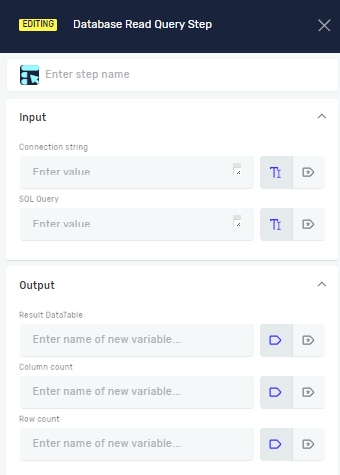Database Read Query Step
Brief description
This step executes the data file or database query at the specified data source and stores the resulting values into the defined variables.
Step Information
Step name (Not required) – the custom name of the process step that labels the editor’s process step box
Input parameters
- Connection string (Required)– existing variable name or value that specifies a data source and the information passed to an underlying driver or provider in order to initiate the connection to the data source
- SQL query (Required)– existing variable name or value containing the Structured Query Language statement used to perform the specific tasks such as data querying, data manipulation, data definition or data control.
Output parameters
- Result DataTable (Required)– existing or new variable name of data type “Datatable” containing the resulting values if the SQL query statement implies resulting values. If a new DataTable variable is created, you may optionally define Custom Columns for it (this is not required).
- Column Name – the desired name for the output column
- Column Type – the .NET data type for the column (e.g., String, Integer, Decimal, DateTime, Boolean, etc.)
- Column count variable name (Required)– existing or new variable name of data type “Integer” containing the resulting data table variable count of columns if the SQL query statement implies resulting values
- Row count variable name(Required) – existing or new variable name of data type “Integer” containing the resulting data table variable count of rows if the SQL query statement implies resulting values
Additional comments

Connection string
It is the structured text that specifies the information about data source and the means of connecting to it. You can find more details about what it is, using next link.
For various data sources different connection string structure is defined. You can find most of the known data source connections using next link.
To be able to connect to the source, proper Provider needs to be installed on the machine’s OS. One of the parameters of the connection string is the provider’s name. For various data sources, there are different providers.
If Robotiq.ai robot is installed on the Windows OS machine, for robot to access various databases you need to install the proper provider.
Next, you can find ODBC providers for commonly used data sources:

